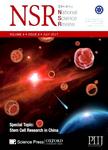An all-metallic nanovesicle for hydrogen oxidation
作者机构:State Key Laboratory of Physical Chemistry of Solid SurfacesCollege of Chemistry and Chemical Engineering Xiamen University Innovation Laboratory for Sciences and Technologies of Energy Materials of Fujian Province(IKKEM) Key Laboratory for Special Functional Materials of Ministry of Education National &Local Joint Engineering Research Center for High-efficiency Display and Lighting Technology School of Materials Science and EngineeringCollaborative Innovation Center of Nano Functional Materials and Applications Henan University Institute of Functional Nano and Soft Materials(FUNSOM) Jiangsu Key Laboratory for Carbon-Based Functional Materials& Devices Soochow University State Key Laboratory of Rare Earth Resource Utilization Changchun Institute of Applied Chemistry Chinese Academy of Sciences Beijing National Laboratory for Condensed Matter Physics Institute of Physics Chinese Academy of Sciences State Key Lab of Organic-Inorganic Composites Beijing University of Chemical Technology Max Planck Institute for Chemical Physics of Solids College of Chemistry and Chemical Engineering and Materials ScienceSoochow University
出 版 物:《National Science Review》 (国家科学评论(英文版))
年 卷 期:2024年第06期
页 面:233-242页
核心收录:
学科分类:07[理学] 070205[理学-凝聚态物理] 08[工学] 080501[工学-材料物理与化学] 0805[工学-材料科学与工程(可授工学、理学学位)] 0702[理学-物理学]
基 金:the financial support of the National Key R&D Program of China (2022YFA1504500) the National Natural Science Foundation of China (22025108, U21A20327, and22121001) start-up support from Xiamen University support from the Max Planck-POSTECH-Hsinchu Center for Complex Phase Materials
摘 要:Vesicle, a microscopic unit that encloses a volume with an ultrathin wall, is ubiquitous in ***, it remains a huge challenge to create its inorganic metal-based artificial counterparts. Here,inspired by the formation of biological vesicles, we proposed a novel biomimetic strategy of curling the ultrathin nanosheets into nanovesicles, which was driven by the interfacial strain. Trapped by the interfacial strain between the initially formed substrate Rh layer and subsequently formed RhRu overlayer, the nanosheet begins to deform in order to release a certain amount of strain. Density functional theory(DFT)calculations reveal that the Ru atoms make the curling of nanosheets more favorable in thermodynamics applications. Owing to the unique vesicular structure, the RhRu nanovesicles/C displays excellent hydrogen oxidation reaction(HOR) activity and stability, which has been proven by both experiments and DFT calculations. Specifically, the HOR mass activity of RhRu nanovesicles/C are 7.52 A mg(Rh+Ru)-1at an overpotential of 50 m V at the rotating disk electrode(RDE) level; this is 24.19 times that of commercial Pt/C(0.31 m A mgPt-1). Moreover, the hydroxide exchange membrane fuel cell(HEMFC) with RhRu nanovesicles/C displays a peak power density of 1.62 W cm-2in the H2-O2condition, much better than that of commercial Pt/C(1.18 W cm-2). This work creates a new biomimetic strategy to synthesize inorganic nanomaterials, paving a pathway for designing catalytic reactors.



